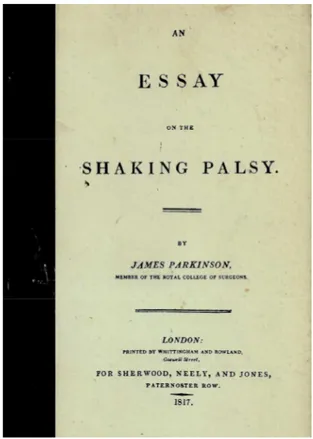192
https://doi.org/10.1590/0004-282X20170006 HISTORICAL NOTE
Parkinson’s disease – 200 years: the
outstanding contribution of “Old Hubert”
Doença de Parkinson – 200 anos: a notável contribuição do “Velho Humberto”
Hélio A. G. Teive1, Renato P. Munhoz2, Andrew J. Lees3
Parkinson’s disease (PD) is the second most common neu-rodegenerative disorder, after Alzheimer’s disease, and the most common hypokinetic movement disorder1.Besides the classical
motor features, including bradykinesia, rigidity, tremor at rest and postural instability, autonomic, psychological and sensory symptoms are also commonly reported1,2. Furthermore, accurate
diagnosis depends, as it did when Parkinson wrote his mono-graph in 1817, on clinical acumen and semiotics3. he patients
that we diagnose with Parkinson’s disease today would have been instantly recognizable to Parkinson and Jean-Martin Charcot, the father of neurology, who suggested “la maladie de Parkinson” as a more suitable rubric than paralysis agitans. In this historical review we contextualize the contribution of James Parkinson in relation to our modern notion of Parkinson’s disease3.
“OLD HUBERT”
James Parkinson was born on April 11th 1755, in London,
UK, where he lived and worked as an apothecary at 1 Hoxton
Square in the Shoreditch district (East London) (Figure 1)4,5,6.
During the years 1793-1795, he also wrote several politi-cal pamphlets, under the pseudonym “Old Hubert”, most of
1Universidade Federal do Paraná, Hospital de Clínicas, Departamento de Medicina Interna, Unidade de Distúrbios do Movimento, Serviço de Neurologia,
Curitiba PR, Brasil;
2University Health Network, Toronto Western Hospital, Morton and Gloria Shulman Movement Disorders Centre and the Edmond J. Safra Program in
Parkinson’s Disease, Toronto, Ontario, Canada.
3UCL and the National Hospital for Neurology and Neurosurgery, Reta Lila Weston Institute for Neurological Studies, Institute of Neurology, Queen Square, London, UK.
Correspondence: Hélio A. G. Teive; Rua General Carneiro 1103/102; 80060-150 Curitiba PR, Brasil; E-mail: hagteive@mps.com.br Conflict of interest: There is no conflict of interest to declare.
Received 30 October 2016; Accepted 21 November 2016. ABSTRACT
Two hundred years after the publication, of “An Essay on the Shaking Palsy”, this indisputable landmark in our understanding of the nature of Parkinson’s disease still remains. What is frequently overlooked, however, is the originality of James Parkinson’s ideas about how clinical observations could be segregated into diagnostic entities. Parkinson was a surgeon apothecary with wide ranging interests outside medicine including geology and paleontology. He was also a strong campaigner for social change and a political pamphleteer, writing under the nom de plume of “Old Hubert”.
Keywords: Parkinson’s disease; history.
RESUMO
A publicação de James Parkinson intitulada “An Essay on the Shaking Palsy”, 200 anos atrás, é considerada uma obra prima de fundamental importância científica. James Parkinson foi um cirurgião apotecário com uma ampla faixa de interesses, além da medicina, incluindo geologia e paleontologia. Ele foi também um grande reformador social e panfletário político, que escreveu sob o pseudônimo de “Velho Humberto”.
Palavras-chave: doença de Parkinson; história.
(Extracted from Google Images: spitalfieldslife.com, October, 01, 2016).
193
Teive HAG et al. Parkinson’s disease – 200 years them criticizing the political system and the government4,5.
One of the most famous was “Revolutions without Bloodshed; or, Reformation preferable to Revolt”, published in 17844,5. James
Parkinson was a member of both the London Corresponding Society and the Society for Constitutional Information. He was liberal in his political viewpoint and perhaps, if he had been alive today, would have supported the ‘Green Party.’ He campaigned strongly for parliamentary reform, better care for the mentally ill
and extension of sufrage4,5,7. Historical data are dubious whether
he was also involved in the very famous “Pop-Gun Plot” to assas-sinate King George III. Between 1799 and 1800, James Parkinson penned several publications designed to be read by his patients such as “Medical Admonitions to Families”, “he Villager’s Friend
& Physician”, “Dangerous Sports”, “Observation on the Nature and Cure of Gout”, and “he Hospital Pupil” (1800).4 He died in 1824
and was buried at St Leonard’s Church not far from where he had lived all his life4,5.
ESSAY ON THE SHAKING PALSY
It is not known what motivated Parkinson to write he
Essay other than that he felt that a distinct and relatively eas-ily recognizable clinical syndrome had slipped the nosolo-gists net. His slim monograph (66 pages) includes a scholarly review of the literature, a clinical description of six patients (all of them male, with ages ranging from 50 to 72 years), three of whom were his patients, two of whom he had watched in the streets and later examined and one whom he had observed on his travels through the Hoxton streets (“the lamented sub-ject of which was only seen at a distance”) 3 (Figure 2). In the
preface, he sets out his intention to give a clinically based description of the disease, and encourages the great anato-mists, like John Hunter, to carry out a detailed examination of the brain3. In chapter one (Deinitions – History-Illustrative
Cases), Parkinson provides a resume at the start of the chapter, which he considers encapsulates the principal features of the
“Shaking Palsy” (“Paralysis Agitans”):
“Involuntary tremulous motion, with lessened muscular power, in parts not in action and even when supported; with a propensity to bend the trunk forwards, and to
pass from a walking to a running pace: the senses and
intellect being uninjured” 3.
He also draws attention to the fact that, while others had pre-viously used the term paralysis agitans, he considered that term to have been used indiscriminately. He then gives a comprehen-sive account of the illness in a typical patient followed by clini-cal vignettes of the six cases3. In chapter two (Pathognomonic
Symptoms Examined – Tremor Coactus – Scelotyrbe Festinans),
he emphasizes that the two main components of the mal-ady had previously been described as if they were distinct dis-eases3. In chapter three (Shaking Palsy), he further discusses the
diferential diagnosis and emphasizes the importance of trem -bling at rest3.Chapter four (Proximate Cause – Remote Causes –
Illustrative cases), Parkinson comments about the possible etiol-ogy of “Shaking Palsy” is less coherent to the modern reader, but it is here that he speculates the pathology may lie in the upper cer-vical cord with rostral extension. Additionally, there is an exten-sive discussion about clinically important symptoms and signs
of “Shaking Palsy”3. In chapter ive (Considerations Respecting
the Means of Cure), Parkinson reviews the limited therapeu-tic options available for what he considers an incurable malady but expresses hope that disease-modifying treatments might be found before too long3,8. More than half a century after Parkinson’s
essay, Charcot, the head of the Neurology Service at the Salpêtrière hospital in Paris, France, and the most celebrated neurologist of the XIX century, suggested the eponymous term “la maladie de Parkinson”9,10. Charcot disliked the term shaking palsy because he
had demonstrated in his Tuesday lectures that patients with the
malady had normal strength, and drew attention to the fact that there were some cases where rest tremor was absent, such as the
celebrated ‘Bach’. Charcot also drew attention to muscular stif -ness as an important, and almost invariable, physical sign and remarked on the frozen facial expression and drooling of saliva9,10.
CONCLUSION
Two hundred years after James Parkinson’s seminal descrip -tion of the shaking palsy, the medical profession now recognizes (From the authors’ book collection)
194 Arq Neuropsiquiatr 2017;75(3):192-194
the malady he described as a discrete clinicopathological entity. Although emphasizing the cardinal motor features of rest tremor, postural deformity and ‘weakness’, Parkinson also described constipation, urinary dysfunction, delirium and depression. Before denigrating the incompleteness of his clinical
References
1. Noyce AJ, Lees AJ, Schrag AE. The prediagnostic phase of Parkinson´s disease. J Neurol Neurosurg Psychiatry. 2016;87(8):871-8.
https://doi.org/10.1136/jnnp-2015-311890
2. Munhoz RP, Moro A, Silveira-Moriyama L, Teive HA. Non-motor signs in Parkinson´s disease: a review. Arq Neuropsiquiatr. 2015;73(5):454-62. https://doi.org/10.1590/0004-282X20150029
3. Parkinson J. An essay on the Shaking Palsy. London: Whittingham and Rowland, for Sherwood, Neely, and Jones; 1817.
4. Clifford Rose F. James Parkinson (1755-1824). In: Clifford Rose F. A short history of neurology: the British contribution 1660-1910. Oxford: Butterworth Heinemann; 1999. p. 108-16.
5. Tyler KL, Tyler R. The secret life of James Parkinson (1755-1824): trhe writings of Old Hubert. Neurology. 1986;36(2):222-4. https://doi.org/10.1212/WNL.36.2.222
6. Williams DR. James Parkinson´s London. Mov Disord. 2007;22(13):1857-9. https://doi.org/10.1002/mds.21643
7. Kempster PA, Hurwitz B, Lees AJ. A new look at James Parkinson’s Essay on the Shaking Palsy. Neurology. 2007;69(5):482-5.
https://doi.org/10.1212/01.wnl.0000266639.50620.d1
8. Khalil R. [History of Parkinson´s disease]. Hist Sci Med. 1996;30(2):215-20. French.
9. Goetz CG. Charcot on Parkinson´s disease. Mov Disord. 1986;1(1):27-32. https://doi.org/10.1002/mds.870010104
10. Teive HA. [The Charcot´s contribution to Parkinson´s disease]. Arq Neuropsiquiatr. 1998;56(1):141-5. Portuguese. http://doi.org/10.1590/S0004-282X1998000100026
observations, it needs to be recalled that he practiced at a time when physical examination of the nervous system, as is carried out today, was not performed and that the natural history of his
disease has now been modiied by the introduction of l-dopa

